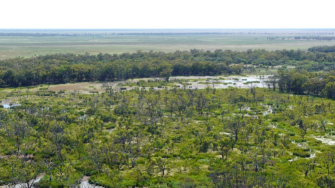
Date: Wednesday, November 18, 2015
Project: Eastern Australian Waterbird Survey
Observer: Terry Korn
With the threat of high temperatures into the 40’s over the coming days we were keen to get an early start from Bourke and head for the Macquarie Marshes for the final wetland of the 2015 survey. On our way we passed by Mt Oxley, a 307m mesa rising from the plain. Named after explorer John Oxley it has Aboriginal significance and is used for communication and tourism purposes.
Mt Oxley near Bourke. Photo: Terry Korn
The dryland country between Bourke and the Macquarie Marshes has extensive clay pans, some of which are being rehabilitated by a method called “ponding” which captures plant seed and water.
Clay pan rehabilitation south east of Bourke. Photo: Terry Korn
The Marshes enjoyed a 53GL environmental flow up to mid-October which was spread over 72 days, with the aim of getting as much of the water as far downstream as possible. Water could be seen in runners as far north as the property “Bluelight” but it hadn’t spread overland so far downstream. Further upstream water was spread throughout the reed beds and under the red gums, giving them a good drink prior to summer and creating a beautiful wetland habitat. Wading through such wet woodlands is a moving experience when the Marsh is in full bloom. All larger open wetlands such as Loudon’s lagoon and Willancorah had sufficient water to attract pelicans, egret, Ibis and ducks.
A typical wetland in the Macquarie Marshes. Photo: Terry Korn
We did 11 east/ west transects across the Marsh but counted few birds as there was limited water. However, most of the survey transects did not cross the main currently existing open wetlands which is where birds are more likely to be found.
The environmental flow has watered core wetlands only. Photo: Terry Korn
Fed by the Macquarie River, this Ramsar site has struggled since the late 1980’s to retain its status as one of the one of Australia’s most important wetlands because of reduced flows. With the introduction of the Murray-Darling Basin Plan environmental water has been purchased for the from willing sellers. Climate change over coming decades may well exacerbate the situation.
Off-river storages hold little water at present. The Macquarie River is in the trees immediately above the storage. Photo: Terry Korn
The “Marshes” are an interesting complex of dry land and wetlands traditionally used for sheep and cattle grazing as well as cropping. About 12% is owned by the government and set aside as a Nature Reserve. The rest is privately owned. All non-flood country is very dry, crops are being harvested and most off-river irrigation storages hold little water as Burrendong Dam is at 21% capacity.
Typical dry-land in the Macquarie Marshes. Photo: Terry Korn
So after over 200 hours of flying over Eastern Australia the 2015 survey has concluded and another set of valuable data has been collected for analysis and to inform future policy and management.
